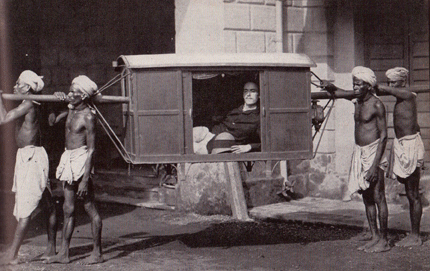
During World War II the Smithsonian Institution issued a number of “War Background Studies.” I recently came across #18 in this series entitled Peoples of India by William H. Gilbert, Jr. (Washington D.C.: Smithsonian Institution, April 29, 1944). I was struck by the archaic presentation of images and the overtly Orientalist writing of Gilbert, who is billed as a “Specialist in Sociology and Anthropology, Legislative Reference Series, Library of Congress” and posted an excerpt from his Introduction in a previous post. The following comments are in reference to this earlier post.
First, the old saw that a picture is worth a thousand words is as apt today as ever. In the last post the image provided there (and again above) of a British “sojourner” in a palanquin shows the Brit, prone and pith helmut at his side, staring outside his box of privilege, while there are two bare-chested bearers in front and two behind. What a compelling metaphor for the colonial view of India. There is no direct engagement between the foreigner and the people; they are merely there to take him from place to place by hand. Ironically, the caption notes that the palanquin is no longer used since the arrival of the railroad, so this image becomes a vestigial reminder of how the present occupies the past for its own comfort. Int his case the white man’s burden is turned upside down; the white man is quite literally the burden here.
Second, notice the adjectival mode in the paragraphs cited in the previous post. What is first mentioned about India is “the unique and the romantic” which epitomizes India for the author. The rulers were “bejeweled,” as though the distinction between tyranny and benevolence of past sovereigns is immaterial. The spices are “wondrous sweet” to the palate of the foreigners who reap the profits of colonial trade. India is a “fabulous” land and one of “legend,” capable of stirring the great European explorers as though the only thing relevant about someone like Columbus is that he “set out in search of better sea routes.” So strong is the legend, thanks to writing like this, that “we still call the aboriginal natives of America “Indians.” Indeed. And Chinese were still “coolies” and black men “niggers” for many of that same population of “we” Americans at the time.
The “air of mystery” survives in the massive continent of India despite the presence of Europeans “in India as rulers and traders for several centuries.” How much of that mystery is due to the colonial mentality of not very much give and a whole lot of take? Of course, for most Europeans engaged in the Empire how could there be anything else but a “strange fascination in the weird events and unusual scenes” of these peoples of India? It did not occur to Gilbert that the four low-caste bearers of the British overlord might have considered their role just as weird, if anyone had bothered to ask them. Villages are not where people live out their lives in poverty, but are “swarming with human life.” Well, at least they warrant being humans, but how many human villagers were at the same time “swarming” in Devonshire or a Maryland suburb? Of course, the Hindu religion could hardly have anything but “grotesque” temples, unlike the Gothic architectural monstrosities that dot the Christian landscape of Europe. And why does India exist at all except to “cast a spell over even the most blase of travelers”? What a decidedly rhetorical question this is.
But romance aside, even though it has been front and center, the real value of India is that it serves as the “keystone” and “political center of gravity” of the British Empire. Little thought is given to whether or not there should continue to be the colonial conglomerate still parading as an Empire even as the world was at war over imperial perils east and west. Now that the Japanese were banging on the borders, the British Raj was in grave danger, not to mention the impact of Hitler’s Luftwaffe on the real center of the British domain. And, of course, the additional complication: Hindus and Muslims, Indian states who preferred to govern themselves, and that nasty caste issue. Yes, indeed, three centuries of European dominance and the potential for conflict had only intensified.
There is more, of course, in Gilbert’s prosaic wordsmithsonianing of India for the war effort.
to be continued …